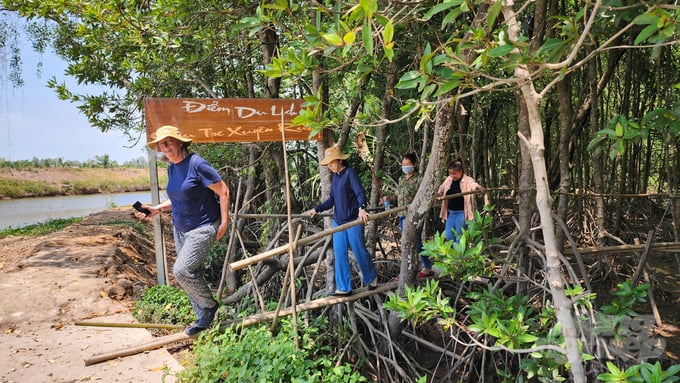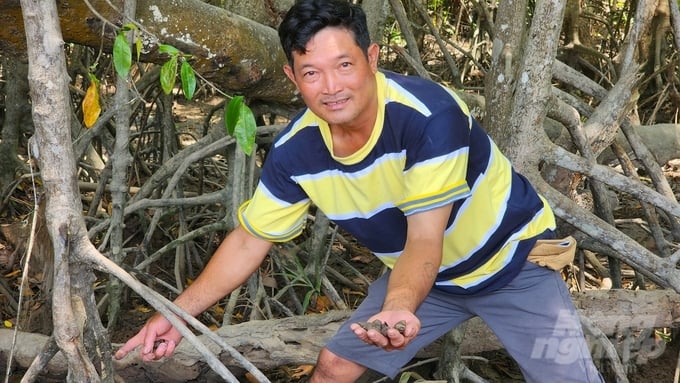May 16, 2025 | 21:18 GMT +7
May 16, 2025 | 21:18 GMT +7
Hotline: 0913.378.918
May 16, 2025 | 21:18 GMT +7
Hotline: 0913.378.918

The eco-tourism site is formed by exploiting the value brought by the forest. Photo: Kim Anh.
Cu Lao Dung district, Soc Trang province is surrounded by 17 kilometers of coastline, with over 1,700 hectares of protective forest, forming a potential alluvial area for the local development of ecotourism. With just a few steps along the dyke road, and the coastal protection forest area belonging to An Quoi hamlet, An Thanh 3 commune, Cu Lao Dung district will appear before tourists' eyes.
The ecotourism site, invested by Mr. Truong Van Dung, has attracted many foreign tourists. This is a model in the group of coastal forest co-management implemented by the Soc Trang People's Committee.
Mr. Dung used to follow his family business of coastal fishing. After realizing that natural resources were steadily declining, and fishing did not bring a stable income for the family, Mr. Dung decided to put an end to his 40 years of floating outside the sea.
Mr. Dung entered into a contract with the agricultural sector of Soc Trang province to exploit and conserve 5 hectares of protective forest. He began to develop his livelihood by raising aquatic products under the forest canopy. Subsequently, he was inspired to develop ecotourism and community tourism based on these activities.
He also joined the local forest protection team, where he was trained in legal knowledge on forest management and protection. The protected forest area has now become a highlight in the family resort, favored by many tourists. Mr. Dung invested in building bamboo bridges and lodgings along the mangrove alluvial area, as well as a system of boats to accommodate tours around the area.

Mr. Truong Van Dung from An Thanh 3 commune, Cu Lao Dung district has developed his livelihood by raising aquatic products under the forest canopy and organizing community tourism. Photo: Van Vu.
Mr. Dung shared that the forest has grown thicker over the years and reached out to the sea, forming a shield protecting the people living in Cu Lao Dung. This region is also known as a natural habitat for monkeys, forest birds. Locals in the area have the opportunity to develop livelihoods in addition to forest protection, and biodiversity conservation of the forest.
Mr. Dung has participated in the livelihood model under the forest canopy supported by the Mekong Delta Integrated Climate Resilience and Sustainable Livelihoods Project (MD-ICRSL) since 2016. His livelihood model has focused on raising mangrove clams, mud creepers, giant mudskipper, crabs, fish, etc. These aquatic products are developed naturally, saving on farming labor. The locals can save both effort and cost because they can utilize natural food sources in the area.
The price of a kilogram of mud creepers currently fluctuates between VND 100,000 and 120,000; VND 45,000 for a kilogram of mangrove clams; over VND 300,000 for a kilogram of crab. After nearly 7 years of implementation, Mr. Dung's family earns a high annual profit, and thus a stable and sustainable livelihood, which is a clear improvement compared to his previous occupation.

Mr. Dung shared that the forest has grown thicker over the years and reached out to the sea, forming a shield protecting the people living in Cu Lao Dung. Photo: Kim Anh.
Mr. Dung has developed a variety of tourism experience services for visitors such as: Walking on bamboo bridges to watch monkeys, mud creepers, mudskippers, and other natural sea animals; boat trips to visit the coastal cork forests or catch fish in the pond.
In addition, Mr. Dung has established linkages with other tourist attraction sites in the region to form a community tourism cluster, providing a full range of services from entertainment, sightseeing to accommodation. According to Mr. Dung, the family's tourism site can expect up to thousands of visitors during peak months.
Ms. Doris Klinnert, a tourist from Germany, was pleasantly surprised when she visited the ecotourism site. She had the opportunity to observe the daily activities of monkeys in the coastal forest area, and travel on a boat to explore the cork coastal forests. Despite her fear of rivers, Ms. Doris has enjoyed these new and exciting experiences.

Soc Trang province plans to focus on planting new trees and protect existing forest area in 2023. Special attention will be given to developing aquaculture models under the forest canopy with the aim of balancing the ecosystem inside the forest. Photo: Van Vu.
Mr. Vuong Quoc Nam, Vice Chairman of Soc Trang Provincial People's Committee, emphasizes that afforestation and forest development are important goals of the province. Forests help protect the environment, minimize the impact of climate change, and prevent erosion of riverbanks and coasts.
On the other hand, forests bring a multitude of benefits for people in coastal areas in terms of developing their livelihoods under the forest canopy. As a result, Mr. Nam requested the Soc Trang Sub-Department of Forest Protection to accelerate afforestation as well as establish a plan to nurture and protect the existing forest area. Models of aquaculture production under the forest canopy to balance the ecosystem inside the forest are also topics of great interest to the local government.
With the goal of developing its forest area in 2022, Soc Trang Sub-Department of Forest Protection has planted over 71 hectares of new protection forests, replanted over 112 hectares of post-exploitation production forests. Nearly 511 hectares of production forest and 426 hectares of protection forest are under the province's care.
Translated by Nguyen Hai Long

(VAN) Cold-barn systems efficiently manage environmental and temperature conditions, which aids in the prevention of respiratory diseases in pigs and protects them from the vectors that transmit African swine fevers.

(VAN) To tackle challenges, the project 'Addressing key technical bottlenecks in the grouper supply chain in Vietnam' has been underway since 2024.

(VAN) The project 'Disease-Resilient and Sustainable Cassava Production Systems in the Mekong Region', funded by the Australian Center for International Agricultural Research (ACIAR), is being implemented from 2024 to 2028.

(VAN) Data from 10,000 farming households will help professionalize production organization and support the implementation of the One Million Hectares Program for High-Quality, Low-Emission Rice Cultivation.

(VAN) FAO Director-General QU Dongyu marks International Day of Plant Health at NENA conference.

(VAN) Deputy Minister of Agriculture and Environment Hoang Trung affirmed that floriculture and ornamental plants are a growing industry that receives significant global attention.

(VAN) The three staple crops dominating modern diets – corn, rice and wheat – are familiar to Americans. However, fourth place is held by a dark horse: cassava.